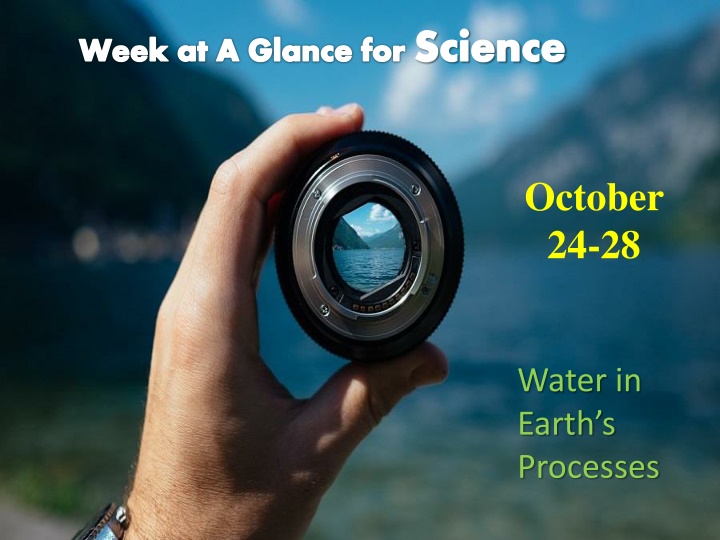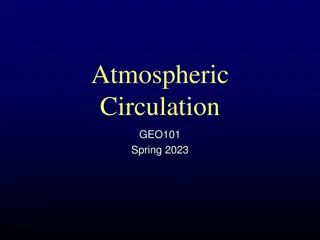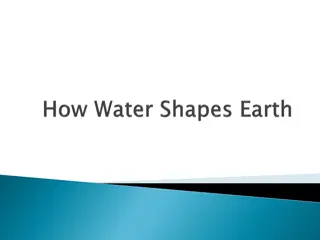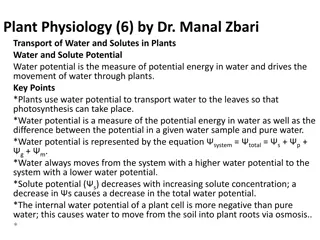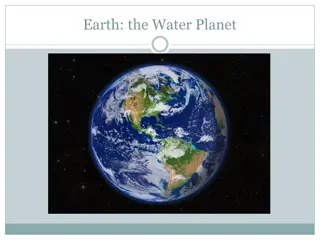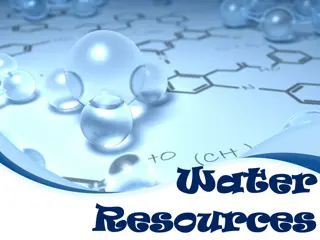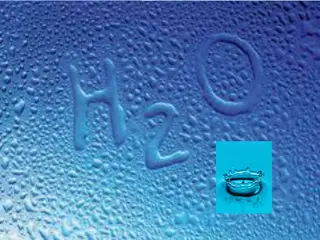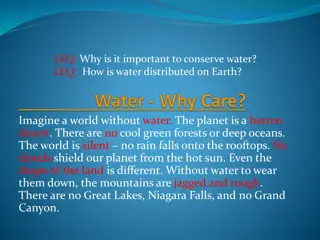Science Week at a Glance: Water in Earth's Processes
This week in Science class, students will focus on the significant role of water in Earth's processes, specifically exploring where water is located on Earth's surface and understanding the various stages of the water cycle. Each day will involve activities, discussions, and investigations related to water distribution and the influence of the sun's energy on atmospheric conditions. The goal is for students to obtain, evaluate, and communicate information about water's importance in Earth's natural systems.
Download Presentation

Please find below an Image/Link to download the presentation.
The content on the website is provided AS IS for your information and personal use only. It may not be sold, licensed, or shared on other websites without obtaining consent from the author.If you encounter any issues during the download, it is possible that the publisher has removed the file from their server.
You are allowed to download the files provided on this website for personal or commercial use, subject to the condition that they are used lawfully. All files are the property of their respective owners.
The content on the website is provided AS IS for your information and personal use only. It may not be sold, licensed, or shared on other websites without obtaining consent from the author.
E N D
Presentation Transcript
Week at A Glance for Science October 24-28 Water in Earth s Processes
S6E3. Obtain, evaluate, and communicate information to recognize the significant role of water in Earth processes. a. Ask questions to determine where water is located on Earth s surface (oceans, rivers, lakes, swamps, groundwater, aquifers, and ice) and communicate the relative proportion of water at each location. b. Plan and carry out an investigation to illustrate the role of the sun s energy in atmospheric conditions that lead to the cycling of water. (Clarification statement: The water cycle should include evaporation, condensation, precipitation, transpiration, infiltration, groundwater, and runoff.)
Monday, October 24 Standard: S6E3. Obtain, evaluate, and communicate information to recognize the significant role of water in Earth processes. a. Ask questions to determine where water is located on Earth s surface (oceans, rivers, lakes, swamps, groundwater, aquifers, and ice) and communicate the relative proportion of water at each location. Learning Target: I can determine where water is located on Earth s surface. Warm-up: Chapter 14 Workbook Packet Work Session: Direct Instruction; students will take notes on identify the distribution of water on earth. Closing: TOD Reminders:
Tuesday, October 25 Standard: S6E3. Obtain, evaluate, and communicate information to recognize the significant role of water in Earth processes. a. Ask questions to determine where water is located on Earth s surface (oceans, rivers, lakes, swamps, groundwater, aquifers, and ice) and communicate the relative proportion of water at each location. Learning Target: I can determine where water is located on Earth s surface. Warm-up: Chapter 14 Workbook Packet Work Session: Direct Instruction; students will take notes on identify the distribution of water on earth. Closing: TOD Reminders:
Wednesday, October 26 Standard: S6E3. Obtain, evaluate, and communicate information to recognize the significant role of water in Earth processes. a. Ask questions to determine where water is located on Earth s surface (oceans, rivers, lakes, swamps, groundwater, aquifers, and ice) and communicate the relative proportion of water at each location. Learning Target: I can determine where water is located on Earth s surface. Warm-up: Chapter 14 Workbook Packet Work Session: Direct Instruction; students will take notes on identify the distribution of water on earth. Closing: TOD Reminders:
Thursday, October 27 Standard: S6E3. Obtain, evaluate, and communicate information to recognize the significant role of water in Earth processes. b. Plan and carry out an investigation to illustrate the role of the sun s energy in atmospheric conditions that lead to the cycling of water. (Clarification statement: The water cycle should include evaporation, condensation, precipitation, transpiration, infiltration, groundwater, and runoff.) Learning Target: I can determine where water is located on Earth s surface. Warm-up: Chapter 14 Workbook Packet Work Session: Direct Instruction; students will take notes on Closing: TOD Reminders:
Friday, October 28 Standard: S6E3. Obtain, evaluate, and communicate information to recognize the significant role of water in Earth processes. b. Plan and carry out an investigation to illustrate the role of the sun s energy in atmospheric conditions that lead to the cycling of water. (Clarification statement: The water cycle should include evaporation, condensation, precipitation, transpiration, infiltration, groundwater, and runoff.) Learning Target: I can illustrate the role of the sun and the water cycle. Warm-up: Chapter 14 Workbook Packet Work Session: Direct Instruction; students will take notes on Closing: TOD Reminders:
Students will have 15 minutes of Homework each evening. 4 Squares (usually a drawing) Rock Cycle Puzzle Chapter 1 or 3 Workbook Pages Powerpoint Study Guide Study Notes or Study Guides Watch Video from Week at a Glance
S6E3. Obtain, evaluate, and communicate information to recognize the significant role of water in Earth processes. a. Ask questions to determine where water is located on Earth s surface (oceans, rivers, lakes, swamps, groundwater, aquifers, and ice) and communicate the relative proportion of water at each location. b. Plan and carry out an investigation to illustrate the role of the sun s energy in atmospheric conditions that lead to the cycling of water. (Clarification statement: The water cycle should include evaporation, condensation, precipitation, transpiration, infiltration, groundwater, and runoff.) c. Ask questions to identify and communicate, using graphs and maps, the composition, location, and subsurface topography of the world s oceans. d. Analyze and interpret data to create graphic representations of the causes and effects of waves, currents, and tides in Earth s systems.
